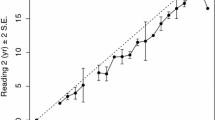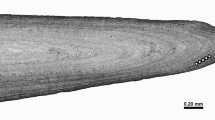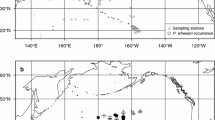Abstract
The age, growth, and maturity of bonnetheads, Sphyrna tiburo, inhabiting estuarine and coastal waters of the U.S. Gulf of Mexico (GOM) were investigated. Based on results of a concurrent population genetics study, two populations were examined, the eastern GOM and western GOM. Vertebrae were collected and aged from 1081 females and 811 males ranging in size 261–1060 mm and 227–898 mm fork length (FL), respectively. The von Bertalanffy growth model provided the best fit to length-at-age data. Eastern GOM von Bertalanffy parameters (length parameters in mm FL) were L∞ = 844, k = 0.23, to = -1.99, and Lo = 310 for females and L∞ = 680, k = 0.39, to = -1.44, and Lo = 294 for males. Western GOM von Bertalanffy parameters were L∞ = 1005, k = 0.20, to = -1.81, and Lo = 298 for females and L∞ = 807, k = 0.30, to = -1.44, and Lo = 285 for males. Maximum observed age was similar between populations with an overall maximum of 17.1 years for females, and 12.1 years for males. Length and age at 50% maturity for the eastern GOM was 661.5 mm and 4.9 years for females, and 564.1 mm and 3.5 years for males and for the western GOM 772.7 mm and 5.3 years for females, and 644.9 mm and 4.4 years for males. Bonnetheads in the eastern GOM generally grow faster and to smaller asymptotic lengths than those from the western GOM; however, longevity is similar between the two populations.









Similar content being viewed by others
Data availability
The datasets generated during and/or analysed during the current study are available from the corresponding author on reasonable request.
References
Akaike H (1973) Information theory as an extension of the maximum likelihood principle. In: Petrov BN, Csaki F (eds) Proceedings of the Second International Symposium on Information Theory. Akademiai Kiado, Budapest, pp 267–281
Beamish RJ, Fournier DA (1981) A method for comparing the precision of a set of age determinations. Can J Fish Aquat Sci 38:982–983. https://doi.org/10.1139/f81-132
Beverton RJH (1954) Notes on the use of theoretical models in the study of the dynamics of exploited fish populations. United States Fishery Laboratory, Beaufort. Miscellaneous Contribution (2), 159 pp
Beverton, RJH, Holt SJ (1957) On the dynamics of exploited fish populations. Fish and Fisheries Series 11, United Kingdom Ministry of Agriculture and Fisheries, United Kingdom. https://doi.org/10.1007/978-94-011-2106-4
Branham CC, Frazier BS, Strange JB, Galloway AS, Adams DH, Drymon JM, Grubbs RD, Portnoy DS, Wells RJD, Sancho G (2022) Diet of the bonnethead Sphyrna tiburo along the northern Gulf of Mexico and southeastern Atlantic coast of the United States. Anim Biodivers Conserv 45(2):257–267. https://doi.org/10.32800/abc.2022.45.0257
Branstetter S (1990) Early life history implications of selected carcharhinoid and lamnoid sharks of the Northwest Atlantic, vol 90. NOAA Tech Rep NMFS, VIMS Books and Book Chapters 40, Gloucester Point. https://scholarworks.wm.edu/vimsbooks/40pp
Brown AN, Frazier BS, Gelsleichter J (2020) Re-evaluation of reproductive cycle and fecundity of finetooth sharks Carcharhinus isodon (Valenciennes 1839) from the Northwest Atlantic Ocean, with new observations on ovarian cycle and reproductive endocrinology of biennially reproducing sharks. J Fish Biol 97:1780–1793. https://doi.org/10.1111/jfb.14542
Cailliet GM, Goldman KJ (2004) Age determination and validation in chondrichthyan fishes. In: Carrier J, Musick JA, Heithaus MR (eds) Biology of sharks and their relatives. CRC Press LLC, Boca Raton, pp 399–447
Cailliet GM, Smith WD, Mollet HF, Goldman KJ (2006) Age and growth of chondrichthyan fishes: the need for consistency in terminology, verification, validation, and growth function fitting. Environ Biol Fish 77:211–228. https://doi.org/10.1007/s10641-006-9105-5
Caña-Hernández S, Lara-Mendoza RE, Mendoza-Carranza M, Pérez-Jiménez JC (2023) Using a multimodel approach to determine the age and growth of an endangered small shark species in the southern Gulf of Mexico. Reg Stud Mar Sci 60:102836. https://doi.org/10.1016/j.rsma.2023.102836
Carlson JK, Parsons GR (1997) Age and growth of the bonnethead, Sphyrna tiburo, from northwest Florida, with comments on clinal variation. Environ Biol Fish 50:331–341. https://doi.org/10.1023/A:1007342203214
Carlson JK, Baremore IE (2003) Changes in biological parameters of Atlantic sharpnose Rhizoprionodon terraenovae in the Gulf of Mexico: evidence for density-dependent growth and maturity. Mar Fresh Res 54:227–234. https://doi.org/10.1071/MF02153
Campana SE, Annand MC, McMillan JI (1995) Graphical and statistical methods for determining the consistency of age determinations. Trans Am Fish Soc 124:131–138. https://doi.org/10.1577/1548-8659(1995)124%3C0131:GASMFD%3E2.3.CO;2
Castro JI (2011) The sharks of North America. Oxford University Press Inc, New York
Chang WYB (1982) A statistical method for evaluating the reproducibility of age determination. Can J Fish Aquat Sci 39:1208–1210. https://doi.org/10.1139/f82-158
Clarke E, Von Schmidt K (1965) Sharks of the central gulf coast of Florida. Bull Mar Sci 15:13–83
Compagno LGV (1984) FAO species catalogue. Vol 4. Sharks of the world. An annotated and illustrated catalogue of shark species known to date. Part 2 - Carcharhiniformes. FAO Fish Synopsis 125, Rome 251–655
Cortés E, Manire CA, Hueter RE (1996) Diet, feeding habits and diel feeding chronology of the bonnethead shark, Sphyrna tiburo, in southwest Florida. Bull Mar Sci 58:353–367
Cortés E (2000) Life history patterns and correlations in sharks. Rev Fish Sci 8:299–344. https://doi.org/10.1080/10408340308951115
Cortés E (2002) Stock assessment of small coastal sharks in the US Atlantic and Gulf of Mexico. National Marine Fisheries Service, Southeast Fisheries Science Center, Panama City, p 133. Sustainable Fisheries Division Contribution SFD-01802-152
Díaz-Jaimes P, Bayona-Vásquez NJ, Escatel-Luna E, Uribe-Alcocer M, Pecoraro C, Adams DH, Frazier BS, Glenn TC, Babbucci M (2021) Population genetic divergence of bonnethead sharks Sphyrna tiburo in the western North Atlantic: Implications for conservation. Aquat Conserv 31:83–98. https://doi.org/10.1002/aqc.3434
Driggers WB III, Oakley DA, Ulrich G, Carlson JK, Cullum BJ, Dean JM (2004) Reproductive biology of Carcharhinus acronotus in the coastal waters of South Carolina. J Fish Biol 64:1540–1551. https://doi.org/10.1111/j.0022-1112.2004.00408.x
Driggers WB III, Frazier BS, Adams DH, Ulrich GF, Jones CM, Hoffmayer ER, Campbell MD (2014) Site fidelity of migratory bonnethead sharks Sphyrna tiburo (L. 1758) to specific estuaries in South Carolina, USA. J Exp Mar Biol Ecol 459:61–69. https://doi.org/10.1016/j.jembe.2014.05.006
Driggers WB III, Hoffmayer ER, Campbell MD, Jones CM, Hannan KM, Sulikowski JA (2020) Spatial variability in the fecundity of Atlantic sharpnose sharks (Rhizoprionodon terraenovae) in the northern Gulf of Mexico. Fish Bull 118:51–62. https://doi.org/10.7755/FB.118.1.5
Drymon JM, Driggers WB III, Oakley D, Ulrich GF (2006) Investigating life history differences between finetooth sharks Carcharhinus isodon in the northern Gulf of Mexico and the western North Atlantic Ocean. Gulf Mex Sci 24:2–10. https://doi.org/10.18785/goms.2401.02
Escatel-Luna E, Adams DH, Uribe-Alcocer M, Islas-Villanueva V, Díaz-Jaimes P (2015) Population genetic structure of the bonnethead shark, Sphyrna tiburo, from the western North Atlantic Ocean based on mtDNA sequences. J Hered 106:355–365. https://doi.org/10.1093/jhered/esv030
Estes RD (1976) The significance of breeding synchrony in the wildebeest. East Afr Wildl J 14:135–152. https://doi.org/10.1111/j.1365-2028.1976.tb00158.x
Fields AT, Feldheim KA, Gelsleichter J, Pfoertner C, Chapman DD (2016) Population structure and cryptic speciation in bonnethead sharks Sphyrna tiburo in the south-eastern USA and Caribbean. J Fish Biol 89:2219–2233. https://doi.org/10.1111/jfb.13025
Fischler KJ, Walburg CH (1962) Blue crab movements in coastal South Carolina, 1958–1959. Trans Am Fish Soc 91:275–278. https://doi.org/10.1577/1548-8659(1962)91[275:BCMICS]2.0.CO;2
Frazier BS, Driggers WB III, Adams DH, Jones CM, Loefer JK (2014) Validated age, growth and maturity of the bonnethead Sphyrna tiburo in the western North Atlantic Ocean. J Fish Bio 85:688–712. https://doi.org/10.1111/jfb.12450
Frazier BS, Bethea DM, Hueter RE, McCandless CT, Tyminski JP, Driggers WB III (2020) Growth rates of bonnetheads (Sphyrna tiburo) estimated from tag-recapture data. Fish Bull 118(4):329–355. https://doi.org/10.7755/FB.118.4.3
Goldman KJ (2004) Age and growth of elasmobranchs fishes. In: Musick JA, Bonfil R (eds) Elasmobranch fisheries management techniques. Asia Pacific Economic Cooperation, Singapore, pp 97–132
Gonzales de Acevado M, Frazier BS, Belcher C, Gelsleichter J (2020) Reproductive cycle and fecundity of the bonnethead Sphyrna tiburo L. from the northwest Atlantic Ocean. J Fish Biol 97:1733–1747. https://doi.org/10.1111/jfb.14537
Harry AV (2018) Evidence for systemic age underestimation in shark and ray ageing studies. Fish Fish 19:185–200. https://doi.org/10.1111/faf.12243
Hoenig JM, Morgan MJ, Brown CA (1995) Analyzing differences between two age determination methods by tests of symmetry. Can J Fish Aquat Sci 52:364–368. https://doi.org/10.1139/f95-038
Holden MJ (1973) Are long-term sustainable fisheries for elasmobranchs possible? Rapp P-V Reun Cons Perm Int Explor Mer 164:360–367
Heupel MR, Simpfendorfer CA, Collins AB, Tyminski JP (2006) Residency and movement patterns of bonnethead sharks, Sphyrna tiburo, in a large Florida estuary. Environ Biol Fish 76:47–67. https://doi.org/10.1007/s10641-006-9007-6
Heupel MR, Carlson JK, Simpfendorfer CA (2007) Shark nursery areas: concepts, definition, characterization and assumptions. Mar Ecol Prog Ser 337:287–297. https://doi.org/10.3354/meps337287
Ims RA (1990) The ecology and evolution of reproductive synchrony. Trends Ecol Evol 5:135–140. https://doi.org/10.1016/0169-5347(90)90218-3
Kimura DK (1980) Likelihood methods for the von Bertalanffy growth curve. Fish Bull 77:765–776
Knip DM, Heupel MR, Simpfendorfer CA (2010) Sharks in nearshore environments: Models, importance, and consequences. Mar Ecol Prog Ser 402:1–11. https://doi.org/10.3354/meps08498
Kroetz AM, Powers SP, Drymon JM, Park K (2015) Anthropogenic modifications to a barrier island influence Bonnethead (Sphyrna tiburo) movements in the northern Gulf of Mexico. Anim Biotelem 3:38. https://doi.org/10.1186/s40317-015-0067-2
Lessa RP, Almeida Z (1998) Feeding habits of the Bonnethead shark, Sphyrna tiburo, from northern Brazil. Cybium 22(4):383–394
Lombardi-Carlson LA, Cortes E, Parsons GR, Manire CA (2003) Latitudinal variation in life history traits of bonnethead sharks, Sphyrna tiburo, (Carcharhiniformes, Sphyrnidae), from the eastern Gulf of Mexico. Mar Fresh Res 54:875–883. https://doi.org/10.1071/MF03023
Lombardi-Carlson LA (2007) Life history traits of bonnethead sharks, Sphyrna tiburo, from the eastern Gulf of Mexico. SEDAR (SouthEast Data, Assessment, and Review) 13-DW-24-V3, SEDAR, North Charleston
Manire CA, Rasmussen EL, Hess DL, Hueter RE (1995) Serum steroid hormones and the cycle of the female bonnethead shark, Sphyrna tiburo. Gen Comp Endocrinol 97:366–376. https://doi.org/10.1006/gcen.1995.1036
Manire CA, Rasmussen EL (1997) Serum concentrations of steroid hormones in mature male bonnethead shark, Sphyrna tiburo. Gen Comp Endocrinol 107:414–420. https://doi.org/10.1006/gcen.1997.6937
Mollet HF, Ezcurra JM, O’Sullivan JB (2002) Captive biology of the pelagic stingray, Dasyatis violacea (Bonaparte, 1832). Mar Fresh Res 53:531–541. https://doi.org/10.1071/MF01074
More WR (1969) A contribution to the biology of the blue crab (Callinectes sapidus Rathbun) in Texas, with a description of the fishery. Texas Parks and Wildife Department, Technical Series, Austin
Natanson LJ, Skomal GB, Hoffmann SL, Porter ME, Goldman KJ, Serra D (2018) Age and growth of sharks: do vertebral band pairs record age? Mar Fresh Res 69:1440–1452. https://doi.org/10.1071/MF17279
Nelson GA (2021) fishmethods: Fisheries methods and models in R. R package version 1.11-2. https://CRAN.R-project.org/package=fishmethods. Accessed June 2021
Oesterling MJ, Evink GL (1977) Relationship between Florida's blue crab population and Apalachicola Bay. In: Livingston RJ, Joyce EA (eds) Proceedings conference on the apalachicola drainage system, vol 26. Florida Marine Research Publication, Gainsville. pp 101–121
Ogle DH, Doll JC, Wheeler P, Dinno A (2021) FSA: Fisheries stock Analysis. R package version 0.9.1. https://github.com/droglenc/FSA. Accessed June 2021
Parsons GR (1993a) Age determination and growth of the bonnethead shark, Sphyrna tiburo: a comparison of two populations. Mar Biol 117:23–31. https://doi.org/10.1007/BF00346422
Parsons GR (1993b) Geographic variation in reproduction between two populations of the bonnethead shark, Sphyrna tiburo. Environ Biol Fish 38:25–35. https://doi.org/10.1007/978-94-017-3450-9_3
Perry HM (1975) The blue crab fishery in Mississippi. Gulf Res Rep 5(1):39–57. https://doi.org/10.18785/grr.0501.05
Peterson CT, Grubbs RD (2023) Temporal community structure and seasonal climatic migration of coastal sharks and large teleost fishes in the northeast Gulf of Mexico. Can J Fish Aquat Sci. https://doi.org/10.1139/cjfas-2022-0124
Plumlee JD, Wells RJD (2016) Feeding ecology of three coastal shark species in the northwest Gulf of Mexico. Mar Ecol Prog Ser 550:163–174. https://doi.org/10.3354/meps11723
Portnoy DS, Puritz JB, Hollenbeck CM, Gelsleichter J, Chapman D, Gold JR (2015) Selection and sex-biased dispersal in a coastal shark: the influence of philopatry on adaptive variation. Mol Ecol 24:5877–5885. https://doi.org/10.1111/mec.13441
Pratt HL, McCandless C, Kohler N, Jensen C, Ulrich GF, Gilligan M (1998) Report of the 1998 Apex predators program cooperative shark pupping and nursery (COASTSPAN) survey. Apex predators program. USDOC, NOAA, NMFS Narragansett Lab, Narragansett
R Core Team (2021) R: A language and environment for statistical computing. R Foundation for Statistical Computing, Vienna. https://www.R-project.org/. Accessed June 2021
Ricker WE (1975) Computation and interpretation of biological statistics of fish populations. Bull Fish Res Board Can 191:1–382
Ricker WE (1979) Growth rates and models. In: Hoar WS, Randall DJ, Brett JR (eds) Fish Physiology vol. VIII: Bioenergetics and growth. Academic Press, New York, pp 677–743
Santos RG, Pinheiro HT, Martins AG, Riul P, Bruno SC, Janzen FJ, Ioannou CC (2016) The anti-predator role of within-nest emergence synchrony in sea turtle hatchlings. Proc R Soc B 283. https://doi.org/10.1098/rspb.2016.0697
Scott-Denton E, Cryer PF, Duffy MR, Gocke JP, Harrelson MR, Kinsella DL, Nance JM, Pulver JR, Smith RC, Williams JA (2012) Characterization of the U.S. Gulf of Mexico and South Atlantic penaeid and rock shrimp fisheries based on observer data. Mar Fish Rev 74:1–27
Scott-Denton E, Cryer PF, Duffin BV, Duffy MR, Gocke JP, Harrelson MR, Whatley AJ, Williams JA (2020) Characterization of the U.S. gulf of Mexico and South Atlantic Penaeidae and rock shrimp (Sicyoniidae) fisheries through mandatory observer coverage, from 2011 to 2016. Mar Fish Rev 82:1–27
SEDAR (SouthEast Data, Assessment, and Review) (2013) SEDAR 34 stock assessment report: HMS bonnethead shark. SEDAR, North Charleston
Speed CW, Field IC, Meekan MG, Bradshaw CJA (2010) Complexities of coastal shark movements and their implications for management. Mar Ecol Prog Ser 408:275–293. https://doi.org/10.3354/meps08581
Steele P (1991) Population dynamics and migration of the blue crab Callinectes sapidus Rathbun, in the eastern Gulf of Mexico. Proc Fortieth Ann Gulf Caribb Fish Inst 40:241–244. https://doi.org/10.18785/goms.1501.04
Sweeney BW, Vannote RL (1982) Population synchrony in mayflies: a predator satiation hypothesis. Evolution 36:810–821. https://doi.org/10.2307/2407894
Ulrich GF, Jones CM, Driggers WB III, Drymon JM, Oakley D, Riley C (2007) Habitat utilization, relative abundance, and seasonality of sharks in the estuarine and nearshore waters of South Carolina. In: McCandless CT, Kohler NE, Pratt Jr HL (eds) Shark nursery grounds of the Gulf of Mexico and East Coast waters of the United States. American Fisheries Society Symposium 50, Bethesda, pp 125–139
Vinyard EA, Frazier BS, Drymon JM, Gelsleichter JJ, Bubley WJ (2019) Age, growth, and maturation of the finetooth shark, Carcharhinus isodon, in the Western North Atlantic Ocean. Environ Biol Fish 102:1499–1517. https://doi.org/10.1007/s10641-019-00929-9
Von Bertalanffy L (1938) A quantitative theory of organic growth (inquiries on growth laws. II). Hum Biol 10:181–213. https://www.jstor.org/stable/41447359
Walker TI (2007) Spatial and temporal variation in the reproductive biology of the gummy shark Mustelus antarticus (Chondrichthyes: Triakidae) harvested off of southern Australia. Mar Fresh Res 58:67–97. https://doi.org/10.1071/MF06074
Yamaguchi A, Taniuchi T, Shimizu M (2000) Geographic variations in reproductive parameters of the starspotted dogfish, Mustelus manazo, from five localities in Japan and Taiwan. Environ Biol Fish 57:221–233. https://doi.org/10.1023/A:1007558324902
Zhang X, Linton B, Cortes E, Courtney D (2013) Shrimp fishery bycatch estimates for Atlantic sharpnose and bonnethead sharks in the Gulf of Mexico, 1972–2011. SEDAR34-WP-18, SEDAR, North Charleston
Acknowledgements
We are especially grateful to the many folks that helped make this study possible. A. Galloway, N. Weber. M. Young, J. Cashour, E. Seubert, C. Manire, C. Peterson, J. Higgs, and Mote Marine Laboratory and TAMUCC Marine Genomics lab members helped with field work, specimen collection, workup, and vertebrae prepping. We would also like to thank the “Trawl and Plankton Branch” at the National Marine Fisheries Service, Southeast Fisheries Science Center, Mississippi Laboratories for specimen collection on the Southeast Area Monitoring and Assessment Program (SEAMAP) trawl surveys. Archived samples were provided by W. Bubley, L. Lombardi, and J. Carlson. Funding for this study was provided by Saltonstall-Kennedy Grant No. NA16NMF4270225. We appreciate the guidance of the editors and two anonymous reviewers who greatly improved the manuscript. This is contribution 865 of the South Carolina Marine Resources Center.
Author information
Authors and Affiliations
Contributions
Bryan Frazier and David Portnoy were responsible for study conception, design, and funding acquisition. All authors were responsible for data collection. Analyses and lab work was performed by Bryan Frazier and Elizabeth Vinyard. The first draft of the manuscript was written by Bryan Frazier, David Portnoy and William Driggers III and all authors commented on previous versions of the manuscript. All authors read and approved the final manuscript.
Corresponding author
Ethics declarations
Ethical approval
All field collections were carried out under necessary state, and university specific protocols. Collection of specimens was performed under SCDNR Scientific Permit #2212, under Florida Fish and Wildlife Conservation Commission Special Activities License SAL-1666-SRP, SAL-1092, and under protocols approved by New College of Florida (IS00001126 and IS00004541) and University of Southern Mississippi (11092217, 13101704, 15101509, 18121301, 18010501).
Conflict of interest
The authors declare no competing interests.
Additional information
Publisher's note
Springer Nature remains neutral with regard to jurisdictional claims in published maps and institutional affiliations.
Supplementary Information
Below is the link to the electronic supplementary material.
Rights and permissions
Springer Nature or its licensor (e.g. a society or other partner) holds exclusive rights to this article under a publishing agreement with the author(s) or other rightsholder(s); author self-archiving of the accepted manuscript version of this article is solely governed by the terms of such publishing agreement and applicable law.
About this article
Cite this article
Frazier, B.S., Vinyard, E.A., Fields, A.T. et al. Age, Growth and Maturity of the Bonnethead Sphyrna tiburo in the U.S. Gulf of Mexico. Environ Biol Fish 106, 1597–1617 (2023). https://doi.org/10.1007/s10641-023-01439-5
Received:
Accepted:
Published:
Issue Date:
DOI: https://doi.org/10.1007/s10641-023-01439-5




